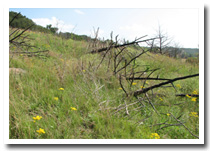 In Iowa land in public ownership is very limited. Public areas can only serve as islands of wildlife habitat in a landscape dominated by row crops and urban sprawl. As a result, fulfilling the habitat needs of the state's diverse wildlife species requires natural resources and wildlife habitat be reestablished and/or protected on private lands.
In Iowa land in public ownership is very limited. Public areas can only serve as islands of wildlife habitat in a landscape dominated by row crops and urban sprawl. As a result, fulfilling the habitat needs of the state's diverse wildlife species requires natural resources and wildlife habitat be reestablished and/or protected on private lands.
Toward that end, the Iowa DNR Wildlife Bureau maintains a Private Lands Program with a focused effort to enroll landowners in conservation programs across the state. Using 4 Private Lands Biologists and 4 Private Lands Technicians stationed in local Natural Resource Conservation Service (NRCS) offices, the efforts of the state's 20 management biologists are greatly enhanced.
The Iowa DNR coordinates its efforts with those of the NRCS, Farm Service Agency (FSA), and the Soil and Water Conservation Districts (SWCD). It also is receiving assistance from and working cooperatively with many non-government organizations such as Pheasants Forever and The Nature Conservancy in its effort to get the habitat back on the land.
This private lands effort involves contacting and advising landowners about possible conservation practices that could be put into place on their lands. Wetlands are designed, shelterbelts and winter food plots are developed and planted, native grass seedings and tree plantings are designed. Funding to get these designed practices on the ground comes from the USDA, IDNR, and private organizations.
Technical Assistance Restoring Wetlands
The Iowa DNR Wildlife Bureau provides technical expertise to landowners interested in restoring wetlands on their property. Private Lands Biologists and Technicians are able to assist landowners in evaluating their properties potential for wetland restoration, setting goals and identifying priorities for their land. Private Lands Biologists and Technicians can also assist landowners by identifying potential partners and federal programs that can help the landowner construct and cover costs of restoring wetlands. Many public Wildlife Management Areas provide examples of the benefits that can be accrued by restoring wetlands. Dugout Creek is one such public wetland that was restored in Dickinson County.
Technical Assistance Restoring/Establishing Grasslands
Historically, much of Iowa was a large expanse of tall grass prairie. Today, only small protected remnants of the tall grass prairie remain. The tall grass prairie was once home to a great diversity of wildlife species including Bison and Elk. Though our needs for agriculture preclude a return to pre-settlement expanses of tall grass prairie, the potential to restore portions of this once great ecosystem remains especially for private landowners who wish to have purple coneflower and bobolinks on their property, and for landowners who wish to improve habitat for pheasants, quail and hungarian partridge.
 For these landowners interested in restoring and enhancing grasslands on their property, the Iowa DNR can provide technical assistance. Private Lands Biologists and Technicians can assist landowners in evaluating their properties potential for grassland restoration, setting goals and identifying priorities for their land. Private Lands Biologists and Technicians can also assist landowners by identifying potential partners and federal programs that can help the landowner seed and generate income by restoring grasslands and other sorts of wildlife habitat.
For these landowners interested in restoring and enhancing grasslands on their property, the Iowa DNR can provide technical assistance. Private Lands Biologists and Technicians can assist landowners in evaluating their properties potential for grassland restoration, setting goals and identifying priorities for their land. Private Lands Biologists and Technicians can also assist landowners by identifying potential partners and federal programs that can help the landowner seed and generate income by restoring grasslands and other sorts of wildlife habitat.
Forestry Practices and CRP
The Conservation Reserve Program is not exclusive to grasslands nor is planting grasslands the only CRP practice a landowner can engage in that will benefit wildlife. Planting trees also prevents soil erosion and benefits wildlife and should be considered by individuals wanting to participate in CRP. The DNR also assists landowners interested in enrolling their land in CRP, and provides information about where people can purchase trees to plant on their land.
For additional information regarding private lands initiatives that can benefit wildlife and landowners contact your local private lands biologist, private lands technicians, or district forester.